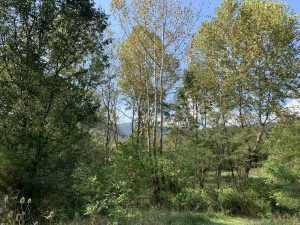
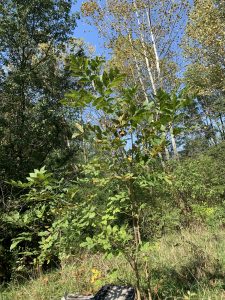
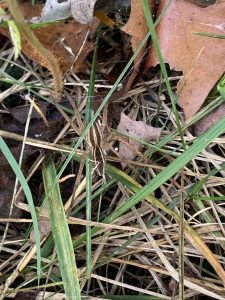 My sit spot is located in between the tree lines on the trail that leads from campus that takes you the back way to Carvin’s, about 500 feet after you walk through the tunnel that interstate 81 passes over. Once I arrived at my sit spot, I found a nice rock to sit on because the grass was still wet from the morning dew. I immediately heard a crow (I heard it the majority of the time I was there). This did frustrate me though because it made it more difficult to hear the sounds of the insects around me. The only real way to describe the noise is the sound of nature. I was at my sit spot during the morning, so the smelling the fresh air was a good way to start the day. One thing I noticed that I didn’t before were the giant spiders running near me and on my things! There were also many tiny green grasshoppers jumping around.
My sit spot is located in between the tree lines on the trail that leads from campus that takes you the back way to Carvin’s, about 500 feet after you walk through the tunnel that interstate 81 passes over. Once I arrived at my sit spot, I found a nice rock to sit on because the grass was still wet from the morning dew. I immediately heard a crow (I heard it the majority of the time I was there). This did frustrate me though because it made it more difficult to hear the sounds of the insects around me. The only real way to describe the noise is the sound of nature. I was at my sit spot during the morning, so the smelling the fresh air was a good way to start the day. One thing I noticed that I didn’t before were the giant spiders running near me and on my things! There were also many tiny green grasshoppers jumping around.
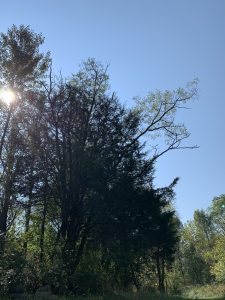
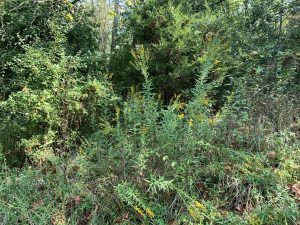
The pine tree that I have been observing hasn’t changed a bit, its still taking up a great amount of space and has its needles. Some of the goldenrods have fallen down due to heavy animal traffic in the area, but they still look the same. The ash tree has started changing however. A few leaves on the tree have started to turn yellow and get a lot of dark spots on them. Some parts of the leaves are already dried up.
I enjoyed walking around my sit spot and exploring new parts of it that I hadn’t seen before. There’s three sycamore trees, one in particularthat I have been watching. I walked much closer to it and examined it because it has lost about 75% of the leaves, while the others still has plenty on them. All of the leaves colors have turned brown. I also got close and personal with a red berry bush that has a very well trafficked deer trail beside it. I also found what appeared to be a couple small wild tomato plants? I went to flip a rock and found a REALLY big spider (I’m not a spider person), but instead of running, I decided to get close, see its markings, and snap a picture of it!
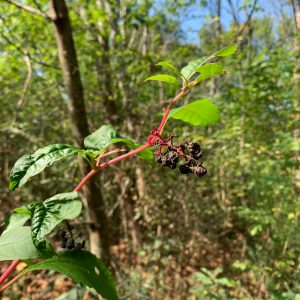
I enjoyed walking around and exploring more of my spot. I definitely would’ve done it even if we didn’t have to. I’m even going to explore a little further next time. I want to find out why my spot is so heavily trafficked. I’m predicting there a water source down the hill. Possibly even a food source, stay tuned!
As I was walking around my spot, I came across a plant that caught my eye with it’s aposematic coloration that it displayed, an American Pokeweed. I immediately knew that this would be a good adaptation to mention. It’s aposematic color basically tells whatever comes in its presence “
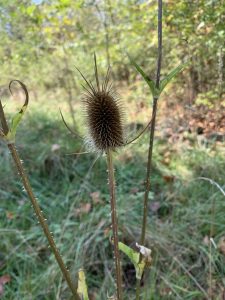
Hey, I’m poisonous!” It is definitely pet poisonous. It’s roots, seeds, and berries are the poisonous parts of it. This adaptation helps keep it from being eaten. Another plant adaptation that keeping to plant from being eaten by animals is the dipsacus sativus follonum flower. It has thorns along the stem and
leaves, and the flower part is very spikey. The third adaptation that I found is the pine tree that I observe. The thick bark protects it from the cold, the branches are flexible so they don’t break easily, and the pine needles help the tree make food year round. These adaptations were not hard to find because they were very obvious.

I really enjoyed reading your blog update! The adaptations you found were super interesting! You have so many more insects and plant diversity than I do in my sit spot haha! I wouldn’t have been able to let spiders crawl on my thighs-I would have gotten them off with a leaf, but I might be more open to it now (since you didn’t get bitten or harmed). Do you think the spiders were coming out due to food scarcity (with lots of the mosquitoes and other insects leaving since fall is here)? Also, do you think that you noticed more grasshoppers than before because there were more, or because you were more observant this time around? I only ask because I saw a myriad of insects that I didn’t notice during my first sitting and I wasn’t sure if it was because my eye was more sensitive to it or if there were actually more. It sounds like your sit spot has some cool changes going on! Keep us updated on the sycamore tree and it’s leaf situation!
The adaptations you found are really interesting to me. I also had an experience with my spider at my sit-spot this time as well, however I freaked out and had to leave my sit-spot for a few minutes to collect myself.